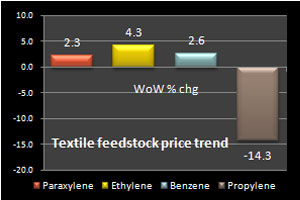
Textiles feedstock strengthens, may reflect in fibre prices later
YarnsandFibers News Bureau 2015-09-28 17:55:00 – MumbaiPetrochemical derivatives are an important starting point for manufacturing textile fibers and filament yarns. While ethylene, paraxylene, benzene and propylene are mother feedstock for production of polyester, nylon, polypropylene and acrylic fibres and filament, any movement in their prices have direct impact on input costs and thus the final product pricing.
In the week ended 28 August, ethylene markets in Asia strengthened and prices were up, driven by firmer demand amid tight supply. The markers, NE Asia while SE Asia rose US$30-35 on the week, sending strong signals for MEG makers downstream. In similar comparison, paraxylene prices rose US$17.50 a ton FOB Korea and CFR Taiwan/China while nominations for October Asian contract prices had started trickling in the range of US$800-850 a ton CFR Asia. This also pushed paraxylene prices in the US.
Benzene prices also rose in Asian market on stable downstream although sentiment was weak limiting trading activity and quiet demand in northeast Asia. The FOB Korea marker was assessed up US$15 a ton week on week tracking similar rises in US and Europe values. The rise helped stabilise downstream caprolactum prices as well as nylon yarn prices
Propylene prices, however, declined sharply in Asian markets during the week on weak demand and supply glut amid thin trading activity. Demand will shrink as China will be on holiday between October 1-7 and South Korea from Saturday to Tuesday. Propylene markers, the CFR China and FOB Korea were assessed down US$85 a ton. The fall impacted downstream polypropylene markets which saw prices edging down. Another derivative, acrylonitrile used to make acrylic fibre, prices continued to march lower amid persistently weak demand and falling cost. This forced acrylic fibre producers to cut offers significantly, narrowing the price gap between the two.
The rise in ethylene, paraxylene and benzene prices have increased cost pressure on their respective derivatives which will see either cost absorption or passing them on to consumers depending how strong or weak are their fundamentals.
Courtesy: Weekly PriceWatch Report
Market Intelligence
Ask for free sample Report

experience
Customer Base
dedicated team
Countries Served Worldwide









